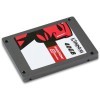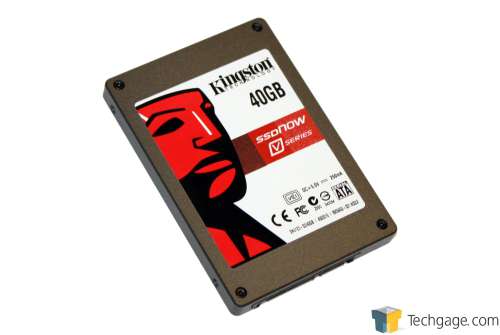- Qualcomm Launches Snapdragon 4 Gen 2 Mobile Platform
- AMD Launches Ryzen PRO 7000 Series Mobile & Desktop Platform
- Intel Launches Sleek Single-Slot Arc Pro A60 Workstation Graphics Card
- NVIDIA Announces Latest Ada Lovelace Additions: GeForce RTX 4060 Ti & RTX 4060
- Maxon Redshift With AMD Radeon GPU Rendering Support Now Available
Kingston SSDNow V Series 40GB

Want to make the upgrade to a solid-state drive, but prefer to avoid the high cost of adoption? Kingston helps ease that pain with its SSDNow V Series 40GB, a modest drive that features Intel’s NAND and impressive G2 firmware, which helps it deliver stellar performance when compared to an HDD, for an easy-to-stomach price.
Page 9 – Final Thoughts
The hard disk drive has always been a stalwart, if not a not-so-silent workhose. As long as it gets the job done, works, and gives us a reasonable assurance that our data isn’t going to vanish into digital oblivion anytime soon, it just isn’t thought about by most users as something worthwhile to upgrade.
Switching to performance RAID brings about its own set of complications, and does not solve the underlying issue that a 14ms drive + 14ms drive in RAID 0 still equals a 14ms access delay. Because data is striped across both disks, each drive must seek alternate chunks of the same files, and while having two (or more) drives reading the file concurrently increases overall throughput, it will not in fact decrease access latencies. When dealing with numerous small file reads and writes, RAID will still suffer from the inherent shortcomings of disk technology.
The simple fact is, flash technology is more than a full order-of-magnitude faster than disk drives in terms of access delay… it’s more like two. There is no penalty before a SSD can read or write data. As SSDs are only just beginning to hit the mainstream, it will be a few years before the wear and typical lifespan of SSDs becomes known, but so far it does not seem to be a major risk. HDDs that are over three years of age are generally considered a liability, as oddly not even all hard disk drives last 3 years. Perhaps here we should mention Kingston warranties this drive for a full 3 years.
This review is about the Kingston SSDNow V Series 40GB SSD, specifically the “Desktop Upgrade Kit” variant that includes everything needed to plug in the SSD and go. So with that in mind we’ll quit with the SSD background and focus on just this drive’s performance.
The 40GB SSDNow V series is intended for first-time SSD buyers to replace a standard hard disk, but even compared against other SSDs, the Kingston drive performs admirably well, consistently placing at or near the top. Against the average disk-based drive, it is a clean sweep, besting the HDD in every single test we could think up, and honestly often by a very wide margin.
The “V” stands for value, and while $130 for 40GB hardly seems like a value, it honestly is with today’s SSD prices. For those that can afford it, buying a larger capacity SSD can drop the $3.25 / GB ratio down to almost $2.15 / GB and we would recommend going that route, but for everyone else that wants an admittedly large slice of SSD performance (or the whole SSD pie) would find themselves quite full with this drive. The performance ranks up with the best SSD available within our review and for now the price is about as low as it gets for a good quality SSD.
So the final important question we have to answer is, is 40GB enough space? A full Windows 7 64-bit install (on our test machine) used 14.1GB of space. The “formatted” capacity of the Kingston is 37.1GB, which means there is 2.9GB additional space available for performance and wear leveling functions. That leaves an admittedly whopping 23GB of space for programs, but that should provide just enough for the average consumer as long as all data and file storage is kept to a secondary drive. For performance (and capacity) reasons, we recommend only using Windows 7 with this drive. (The equivalent Vista install required roughly an extra 6GB of space over Windows 7).
One trick available to Windows 7 users that becomes extremely useful here is that Windows 7 makes it easy to “store” the contents of a folder elsewhere without actually physically moving the folder. Start by navigating to the C:UsersYOURUSERNAME directory. It will work with any system folder in this directory, so for example right-click “My Documents”, click “Properties”, then click the “Location” tab. This displays the path the actual files are stored in, but by clicking the “Move” button, any folder on any other drive can be selected. This preserves the folder itself so it behaves like normal without changing anything, but any files placed inside the folder are physically stored in the new location.
Let’s be clear. Solid-state drives won’t make the CPU calculate faster and they won’t make the FPS on your favorite game increase (unless you typically run AV scans in the background in which case they just might), but what they can do is make everything load faster. And they are the best-suited for multiple concurrent storage operations, heavy multi-tasking, or any possible scenario that becomes bottlenecked by the hard drive. If you are looking to buy the most affordable SSD without sacrificing performance or reliability, and 40GB of space is sufficient for your needs, then we can easily recommend the Kingston 40GB SSDNow V SSD as a worthy upgrade to any mechanical drive. Just make sure you get the 40GB version that has the Intel controller if you do!
Editor’s Note: After this article was written, we learned from Kingston that this 40GB model has been discontinued, though it remains available at e-tailers until supplies are diminished. The reason for the discontinuation is that Intel opted to not allow Kingston use of the updated firmware that would enable TRIM. Instead, Intel’s own 40GB SSD (which costs the same as Kingston’s) does include TRIM support. Therefore, we quicker recommend Intel’s drive over Kingston’s, as TRIM is a super-sweet feature to have. Kingston will be releasing a 30GB SSD to replace this one next month, which will feature a Toshiba controller with Toshiba NAND, and also include TRIM support. The pricing will be $99.99, though there will be a special offer to get it for $79.99 after mail-in-rebate. We’re not sure how long this special deal is supposed to last, however.
Benchmarking storage without resorting to a slew of synthetic test regimens is not easy! If you have any suggestions or real-world scenarios that tend to brutalize your hard drive, or if you are wondering if a SSD might help with the type of workload you usually work with, then please drop by our forums and let us know! We are always looking for feedback and to better expand our content to be as comprehensive and real-world as possible.
Discuss this article in our forums!
Have a comment you wish to make on this article? Recommendations? Criticism? Feel free to head over to our related thread and put your words to our virtual paper! There is no requirement to register in order to respond to these threads, but it sure doesn’t hurt!
Support our efforts! With ad revenue at an all-time low for written websites, we're relying more than ever on reader support to help us continue putting so much effort into this type of content. You can support us by becoming a Patron, or by using our Amazon shopping affiliate links listed through our articles. Thanks for your support!





